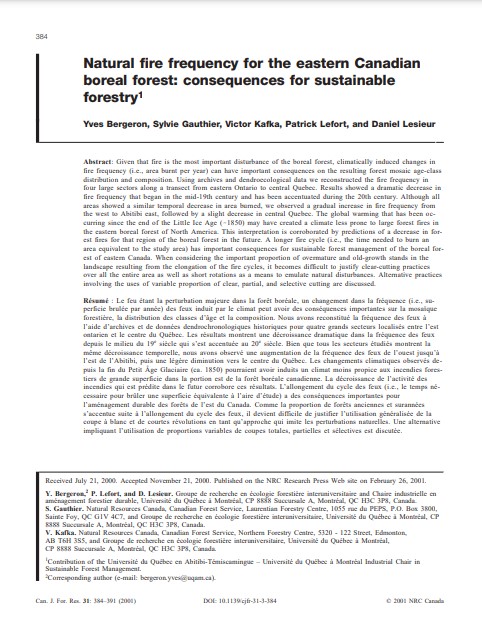Natural fire frequency for the eastern Canadian boreal forest: consequences for sustainable forestry
Bosque Modelo:
Lake Abitibi
Temática:
Gestión forestal
Tipo de documento:
Artículo científico
Resumen
Given that fire is the most important disturbance of the boreal forest, climatically induced changes in fire frequency (i.e., area burnt per year) can have important consequences on the resulting forest mosaic age-class distribution and composition. Using archives and dendroecological data we reconstructed the fire frequency in four large sectors along a transect from eastern Ontario to central Quebec. Results showed a dramatic decrease in fire frequency that began in the mid-19th century and has been accentuated during the 20th century. Although all areas showed a similar temporal decrease in area burned, we observed a gradual increase in fire frequency from the west to Abitibi east, followed by a slight decrease in central Quebec. The global warming that has been occurring since the end of the Little Ice Age (-1850) may have created a climate less prone to large forest fires in the eastern boreal forest of North America. This interpretation is corroborated by predictions of a decrease in forest fires for that region of the boreal forest in the future. A longer fire cycle (i.e., the time needed to burn an area equivalent to the study area) has important consequences for sustainable forest management of the boreal forest of eastern Canada. When considering the important proportion of overmature and old-growth stands in the landscape resulting from the elongation of the fire cycles, it becomes difficult to justify clear-cutting practices over all the entire area as well as short rotations as a means to emulate natural disturbances. Alternative practices involving the uses of variable proportion of clear, partial, and selective cutting are discussed.
Información Bibliográfica
Autor:
Bergeron, Y, S Gauthier, V Kafka, P Lefort and D Lesieur.
Revista:
Canadian Journal of Forest Research
Año:
2001
N°:
-
País :
Canadá
Páginas:
384 - 391
Volumen:
31
Idioma:
Ingles
Palabras claves
Fire, frequency, Model forest, Canada





